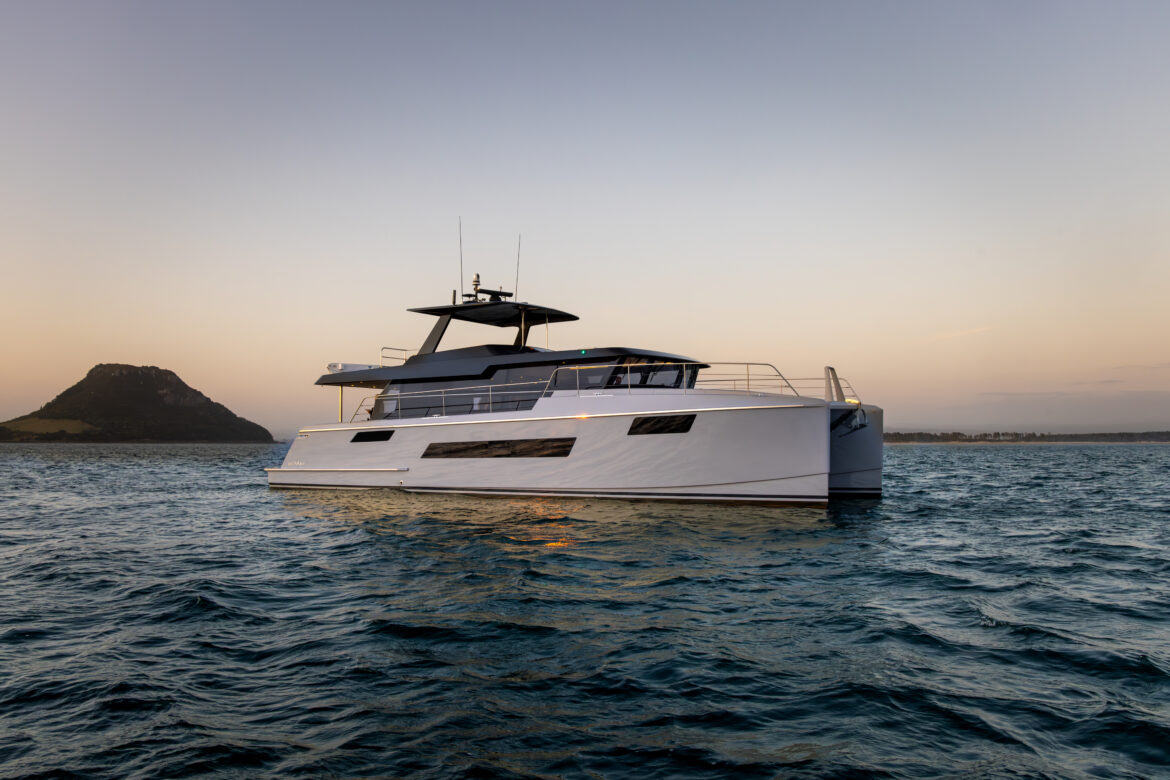OUT OF THIS WORLD
Nic de Mey’s aptly-named new 18-metre Spaceship catamaran is a stunning “out of this world” creation, combining genuine range at speed with a truly spacious, inventive interior.
Sitting in the cockpit of Wilma², the first of his new DEMEY 60 Spaceships (the second is already well underway in his Tauranga yard), Nic de Mey has no doubts about what separates this boat from the rest: “Range at speed.”
“These days, there are quite a few boats around this size that can cross the Tasman or head up to the Islands. But how many have the ability to do it at the speed they choose? Most need to throttle right back to around 8 knots to get there without strapping on extra fuel.
“Wilma², on the other hand, can travel at pretty much any speed the owner chooses. For example, with its 10,000-litre fuel capacity, it can cover an impressive 1600 nautical miles at a relatively quick 18-21 knots and, just as importantly, can do so in comfort.”
That means, when Wilma² heads off to her new home in Sydney, her trans-Tasman crossing is expected to take just 2 and a half days, without troubling either her fuel reserves or her crew.

However, as impressive as this range at speed is, there is far more to like about the DEMEY 60 than just that. For one thing, this is a BIG vessel. Watching it come in to berth in the Tauranga marina, it captures the eye in a way most 18-metre monohulls (or even other catamarans) don’t. Adjectives such as “burly”, “staunch”, and “muscular” spring to mind. Boats are normally referred to as “she” and “her” but despite her name, at first sight, Wilma² strikes me as unashamedly masculine. This is, unquestionably, a man’s boat.
This is not to say it is ugly or brutish in any way. Quite the contrary. It is undeniably attractive and well-balanced with lovely lines. It’s just way more solid front rower than silky winger. To me, it has the air of: “I’m a-coming through, don’t get in my way.”
It also seems to dominate the space around it, making it appear much bigger than its 18.3-metre LOA. Part of that is probably its substantial 6.9-metre beam although its forward raked screen, high proud bows and towering boat deck cover also play their part.
This size was an important consideration for her owner, too. He was keen to get a vessel that was as big as possible without needing crew to man it, clean it or service it. He also wanted a design that had no speed “hump”, had great stability at rest and underway (without the need for a gyro and additional generator) and had great all- round visibility without compromising either privacy or protection.
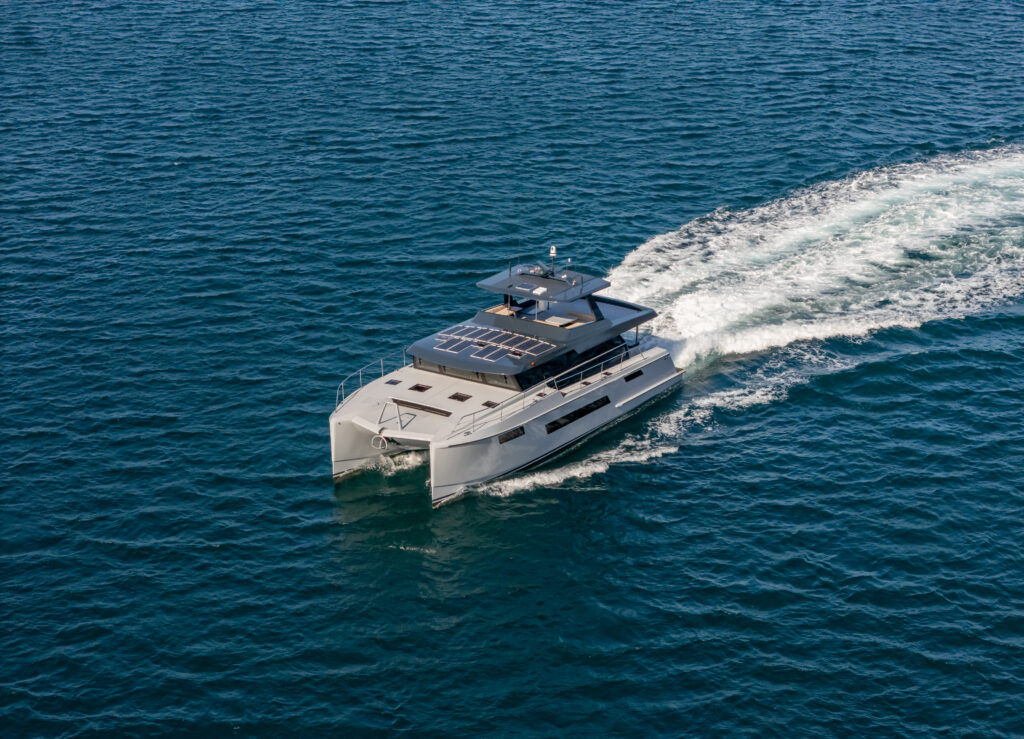
LIGHTWEIGHT PERFORMANCE
Wilma² is a Roger Hill design semi-displacement catamaran. Its composite construction consists of carbon fibre and e-glass epoxy with a foam core supplied by Gurit. Nic de Mey, renowned for his lightweight performance vessels, has ensured it displaces just 32 tonnes (half full) and, powered by a pair of 550hp Cummins diesels through conventional shafts, has a top speed of 26 knots and an “ideal” cruising speed of 20.6 knots.
In response to the owner’s request for a “no speed hump” ride, Wilma² varies just one degree in trim from at rest to flat out and without any use of trim tabs (a set of Humphree Interceptors are planned to be installed, although it is not clear if they will be needed).
For such a substantial vessel, Wilma² is surprisingly easy to control. The skipper has a choice of using a centrally mounted toggle, a joystick or a Dockmate remote, as well as the effective twin Vetus Pro 210 bow thrusters, which provide exceptional manoeuvrability.
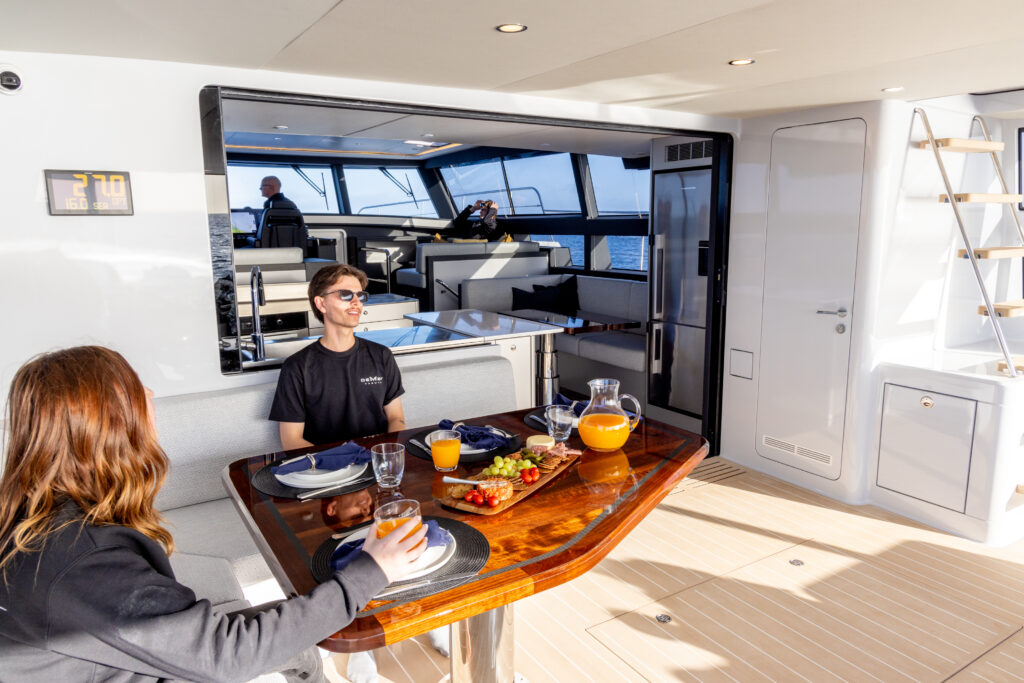
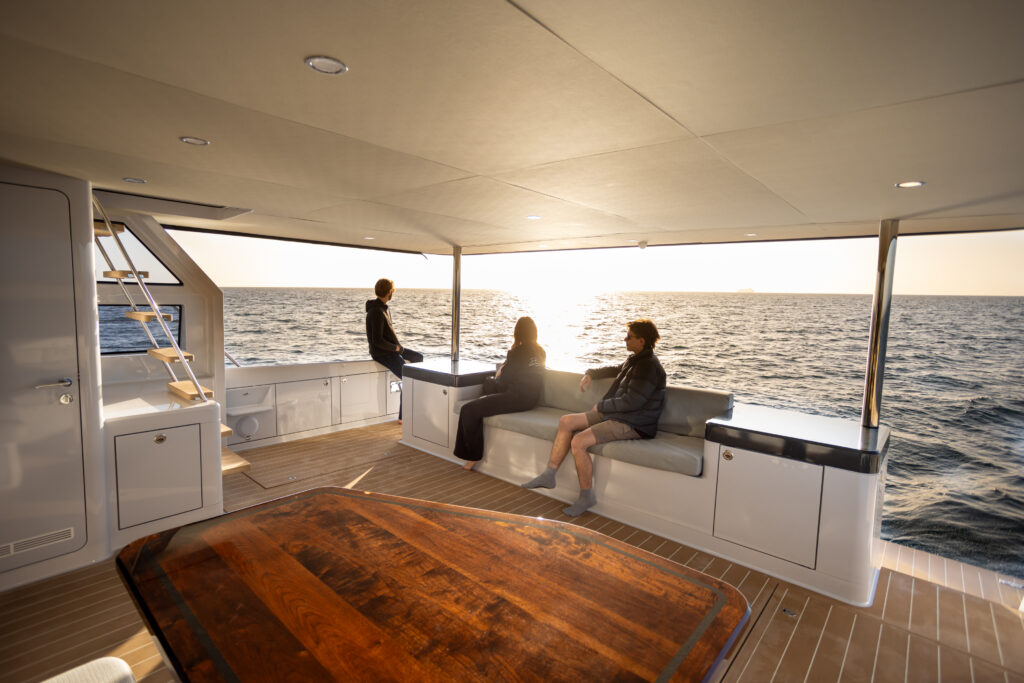
GREAT ONBOARD SPACES
Apart from that imposing appearance, the thing that most impresses me about Wilma² is the way the space on board has been used. Obviously, at 18.3m LOA and nearly 7m across, there is no shortage from which to work but in this writer’s experience, that doesn’t always mean good outcomes.
Here it does. From the huge elevated boat deck, through the large, almost enclosed cockpit and the open plan saloon (with its numerous little niches), to the four separate and spacious cabins, the owner, Nic de Mey and the company’s impressive in-house design team (responsible for all the interior details, accents and the like) have combined superbly to create something that really is special.
With the owner a keen sailor and not at all interested in fishing (and with a son who is an aspiring Olympian in the sport), the design team have been free to focus on making Wilma²’s aft areas all about accessing the sea, launching and retrieving smaller vessels and being able to swim in safety.

To ensure the latter, the large swim platform drops down a full 400mm below the water, providing a safe space for kids to swim without being exposed to deeper water. In a handy garage between the pontoons lives the ship’s custom-made carbon tender, a 4m catamaran easily launched and retrieved on rails.
Up the stairs, the cockpit features not only a huge shady overhang (from that massive boat deck above) but also actual windows deep down both sides. This sturdy glazing ensures both protection and privacy without compromising visibility. To ensure the owner and his guests do not dehydrate in the hot Australian sun, the aft settee is flanked by a pair of handy fridges, ideal for housing refreshments. There is also a large pullout freezer drawer under the ladder up to the boat deck. A handy day head sits just inside the entrance to the saloon.
There is also a separate settee and table area over on port, handily positioned next to the galley. Like the matching tables up on the boat deck, this one is dark, polished walnut, complete with carbon inlays. These accents and the meticulous attention to detail that accompanies them are found throughout the boat, from the custom-made air conditioning vents to the scribed indents on many of the upright surfaces and internal “invisible” hinges on all the cockpit hatches.
With the entire aft bulkhead opening up, there is a truly seamless transition from the outside space to the in. As is usually the case these days, the galley is situated aft to port to easily service both the cockpit and the saloon. What is not usual, is the galley bench top created by the Mt Marine Engineering team, a 7mm stainless steel one-piece creation that has literally been pressed into shape. This is complemented by striking hand-finished metallic silver composite facades on the cupboards and drawers.

POWER TO BURN
The oven, dishwasher and fridge freezer are all standard domestic models and, thanks to a deliberately designed electrical system, able to run virtually continuously without troubling the generator. “One of the owner’s requests,” says Nic, “was that all the house loads, including the water heating, air conditioning and the dishwasher, were able to run throughout the night and, in the morning, the kettle could be boiled and the hair dryer used, all while maintaining a silent ship.”
To do this, Nic and his team installed a 36kWh lithium-ion battery bank, a set of inverters, and a large solar array. This means the generator is solely used as an auto-start failsafe and is hopefully seldom if ever, needed.
Another of the owner’s “must haves” was a centre line helm that not only boasted great all-round visibility but was also an integral part of its surrounds. It is to his credit that Nic has not only managed to accommodate this but has also combined it with another desire: for there to be distinct areas within the saloon in which different members of the crew can “do their own thing.”
The result is a variety of different zones around the saloon and flanking the raised centre helm where individuals or small groups can be both separate and close to the skipper and others on board.
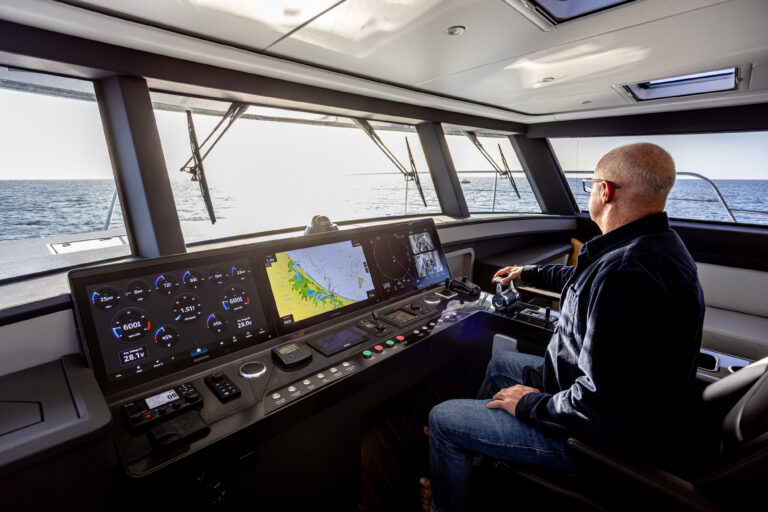
Dominating the helm station are three 22-inch Garmin 4k MFD screens. With connections to the engines, the C-Zone digital monitoring system and the multiple cameras (boat deck, engine room, cockpit, transom and bow), as well as the GPS, radar and sonar, they deliver all the information the skipper needs, in precisely the way they want it. A Perspex panel, containing push button controls and large, prominent colour-coded start/stop buttons for the engines, provides a striking big- ship-like contrast to the stylish carbon fibre surrounds.
The elevated position, large raked trawler-like windscreen, the large windows down each side and the open plan saloon behind combine to give almost complete 360-degree visibility, a real bonus on a vessel of this size.
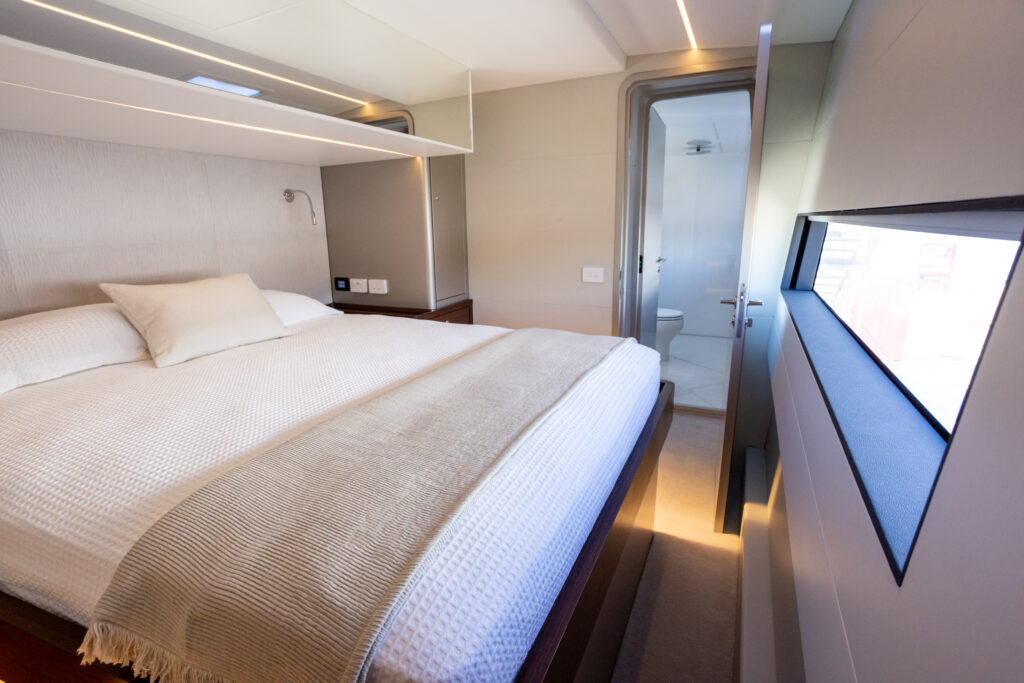
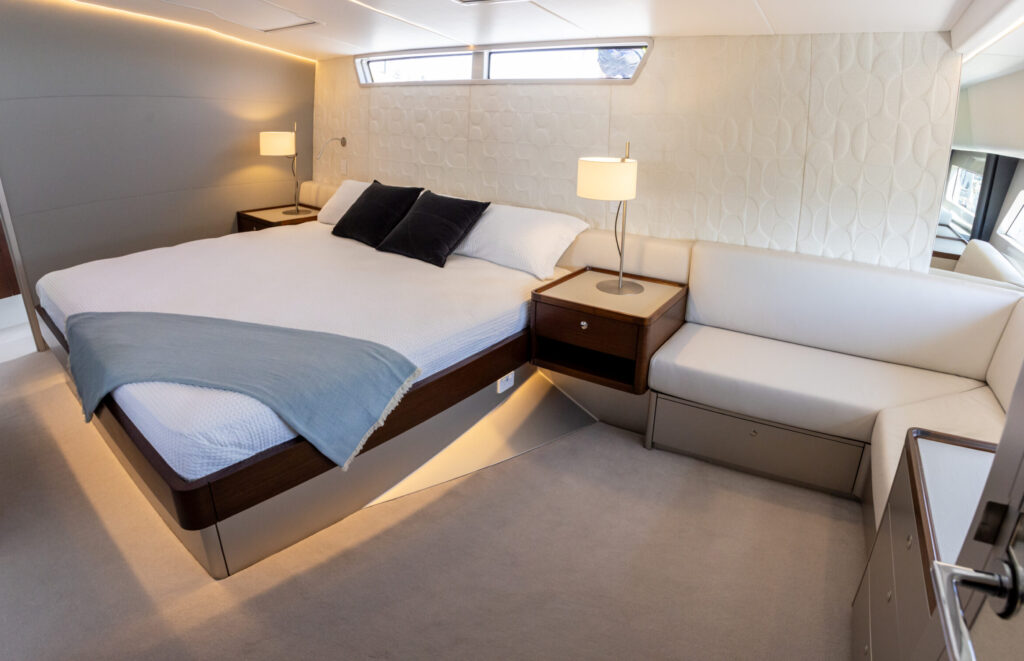
FOUR SPACIOUS CABINS
Wilma² has three distinct accommodation areas: the bow for the owner, the port pontoon for the VIP guest cabin and the “kid’s quarters” over on starboard. The former is a full beam affair with views for’ard and to starboard and, from its large fore and aft ensuite to port. The king-sized island berth is complemented by a comfortable settee, subtle strip lighting and more of those wonderful de Mey accents. The VIP cabin is also blessed with great views, a queen-sized bed and attractive metallic silver and walnut joinery, complemented with aromatic cedar lining in the hanging locker. There is also an aft head, which also services the kid’s quarters, and the ship laundry. Metallic silver finishing is also a feature of the twin starboard cabins, each with its own distinct feature wall.


HUGE COVERED BOAT DECK
Nic boasts that Wilma² has the toy stowage of a 90ft monohull, and he is probably right. In addition to that aft garage for the tender there is a huge boat deck above the cockpit. With multiple anchor points and its own 250kg davit, it easily accommodates the owner’s jet skis, sailing dinghies and the like. It also has twin lounging areas, with suede upholstery and walnut tables, the port side one capable of dropping down and forming a delightful alfresco double berth. For’ard of the boat deck is the ship’s solar panel array, 12 full-sized panels doing their job of maintaining that large battery bank. For those that need to move around outside, the side and foredecks are covered in an effective antiskid, anchoring duties are handled by the Lone Star GX6 drum winch (their largest) and all the hatches are flush mounted with drainage for’ard to avoid any unsightly run-off down the sides.
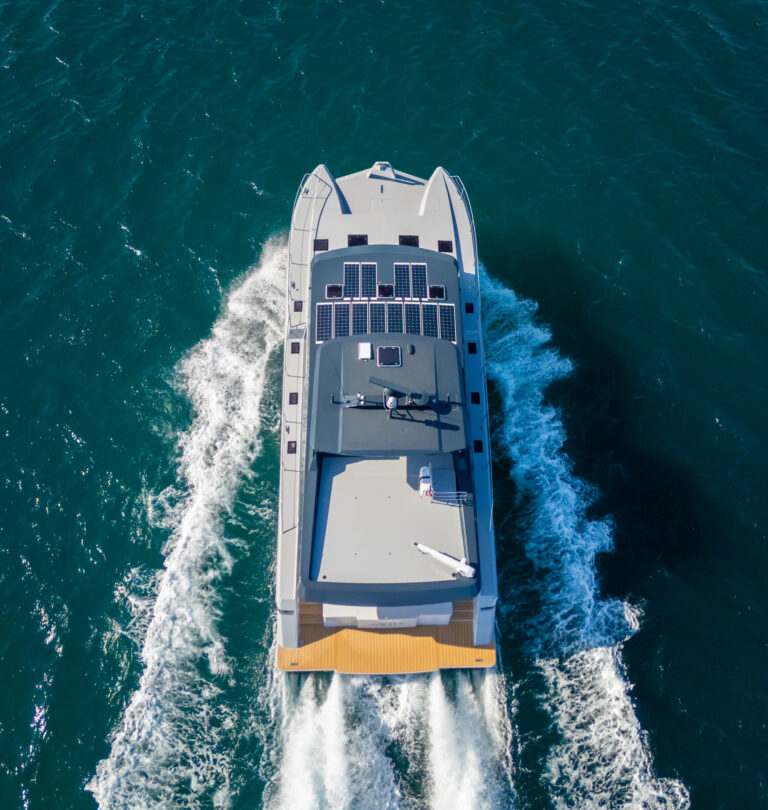
SUMMARY
Wilma² is a seriously impressive vessel, whichever way one looks at it. It is an example of what happens when there is close collaboration between an experienced owner who knows exactly what he wants, a top-of-his field designer who literally owns the semi-displacement space and a creative master boatbuilder with an almost pathological focus on detail and finishing. Its size and muscularity will ensure that those who encounter it in a marina or bay will be sure to stop and take another look. For those lucky enough to be invited onboard, they will find an enchanting mix of stylish design, stunning attention to detail, brilliantly practical functionality and lots of the very latest technology.
A veritable Spaceship indeed.

SPECIFICATIONS
Designer Roger Hill
LOA 18.3m
LOH 18m
Beam 6.9m
Displ (1/2 full) 32 tonnes
Max Speed 26 knots
Construction Composite (carbon & e-glass epoxy w/foam core)
Fuel Cap 10,000 litres
Water Cap 1800 litres
Engines Make 2 x Cummins 550hp diesels
PERFORMANCE DATA
RPM LPH STW LPNM
1400 27 8.12 3.32
1600 34 9.21 3.69
1800 51 12.4 4.11
2200 77 14.2 5.42
2600 112 18 6.22
2650 118 18.5 6.37
2800 135 20.6 6.55
3200 190 24.5 7.75
3300 220 26.2 8.39


